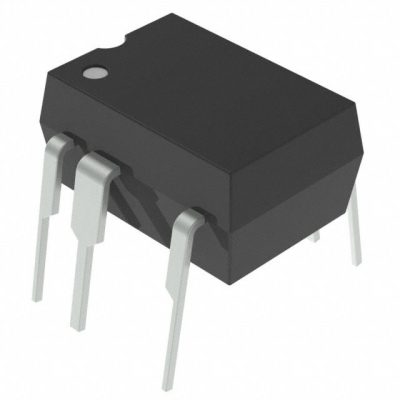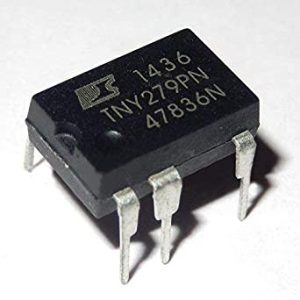TNY279PN
Part Number: TNY279PN
Manufacturer:Power Integrations
Description: AC/DC Converters
Shipped from: Shenzhen/HK Warehouse
Stock Available: Check with us
ICRFQ.com - Electronic Components Distributor in China Since 2003

Part Number: TNY279PN
Manufacturer:Power Integrations
Description: AC/DC Converters
Shipped from: Shenzhen/HK Warehouse
Stock Available: Check with us
| Datasheet | |
|---|---|
| Category | Integrated Circuits (ICs) |
| Family | PMIC – AC DC Converters, Offline Switchers |
| Manufacturer | Power Integrations |
| Series | TinySwitch?-III |
| Packaging | Tube |
| Part Status | Active |
| Output Isolation | Isolated |
| Internal Switch(s) | Yes |
| Voltage – Breakdown | 700V |
| Topology | Flyback |
| Voltage – Start Up | – |
| Voltage – Supply (Vcc/Vdd) | – |
| Duty Cycle | 65% |
| Frequency – Switching | 132kHz |
| Power (Watts) | 32W |
| Fault Protection | Current Limiting, Open Loop, Over Temperature, Over Voltage, Short Circuit |
| Control Features | EN |
| Operating Temperature | -40°C ~ 150°C (TJ) |
| Package / Case | 8-DIP (0.300″, 7.62mm), 7 Leads |
| Supplier Device Package | DIP-8C |
| Mounting Type | Through Hole |
The TNY279PN contains an oscillator, a high voltage switching current source, a current limit that the user can specify, and circuitry for the thermal shutdown. The oscillator can handle up to 700 V of power. The IC family utilizes the ON/OFF control strategy, providing a design-flexible solution at a low overall system cost and increased power capability.

Direct current (DC) and alternating current (AC) are both ways electrical power can be transmitted via wires. Direct current (DC) travels only in one direction at a constant voltage, but alternating current (AC) travels backward and forwards due to an oscillating voltage. AC is the predominant method of conveying power since it offers various advantages over DC, including cheaper distribution costs and an easy manner of changing between voltage levels, thanks to the discovery of the transformer. On the other hand, DC is the less prevalent technique of transporting power.
AC power that is sent over long distances at a high voltage and is subsequently transformed to a lower voltage is a source of power that is more efficient and safer to use in residential settings. High voltage can reach anywhere from 4 kilovolts (kV) to 765 kV, depending on the area. Depending on where you live, home AC mains might range from 110V to 250V. The standard voltage for an AC main line in the United States is 120 volts.
AC-DC Converters direct an alternating current, whose voltage is also changing, into reactive impedance elements such as inductors (L) and capacitors (C), where the energy can be stored and integrated. This occurs as the voltage of the alternating current also changes. Through this process, the power connected to the positive and negative potentials is disassociated from one another.
Filters are utilized to smooth out the energy that is stored, ultimately forming a DC source that may be used in other circuits. This circuit can appear in various configurations, but it will always consist of the same core components. It may also contain one or more stages of conversion.
The AC-DC converters shown in figure 1 are called “forward converters,” They have a higher efficiency than AC-DC converters with a simpler architecture known as “flyback converters.”
Although this point is glossed over, the primary distinction between a flyback converter and a forward converter is that the operation depends on the energy stored in the air gap of the transformer included in the circuit. Aside from this distinction, they can use the same fundamental building components.
As was mentioned previously, there are a few different types of converters in their topology. Some examples of these architectures are flyback and buck-flyback converters. These are frequent topologies because they involve transformers, have a low component count, and, compared to other possibilities, can have a lower overall cost.
Transformers are used in place of inductors in flyback converters, similar to buck-boost AC-DC converters (step-up/step-down converters). By employing an active or passive rectification circuit, the energy stored within the transformer can be utilized to commutate the secondary winding. Because it often has the most straightforward control loop and the lowest cost, the discontinuous mode (DCM) flyback converter is the most common type. This occurs when the current flowing through the transformer reaches zero. Constant current mode (CCM) flyback converters are necessary for greater power levels; however, they lead to larger transformer winding losses because of their continuous conduct.
The degree of load can cause many power supplies to flip between different operating modes. More complicated circuits, such as quasi-resonant (QR) and valley switching/variable frequency variants on the flyback topology, optimize when and how switching happens to increase efficiency. This is accomplished through QR flybacks through recycling energy from non-ideal leaky inductances, and valley switching helps prevent spikes generated by an overshoot. Applications requiring low power consumption are common usage for them.
AC-DC converters can protect against overcurrent, overvoltage, and short circuits. Ruggedized devices are resistant to wear and stress and are often used in the military. Specific switching converters come equipped with either an active or passive power factor correction to reduce the amount of distortion and improve the power factor. There is a possibility of a switch that can be activated and deactivated remotely.
In practically all electronic and electrical gadgets, the AC to DC Converters can be found doing their thing. Household applications, including vacuum cleaners, washing machines, refrigerators, and electric rice cookers, use them as power supply circuits. These circuits are used in households. AC-to-DC Converters are a significant component of many valuable devices used in everyday life, such as computers, televisions, and chargers for mobile phones.
The vast majority of electronic sensors and modules can only function when supplied with DC power; as a result, they require AC to DC Converters. They are also used in telecommunications, signs displays, factory automation, building automation, medical equipment, industrial automation, and building automation.
Additional uses for AC to DC Converters can be found in managing renewable energy, testing and measuring equipment, and the aerospace, military, and transportation sectors.
We appreciate you taking the time to read this article; if you have any questions relating to it, please feel free to leave them in the comment box below, and we will do all in our power to respond to them. You are more than welcome to check out some of the fantastic stuff we have on our website, which is undoubtedly worth your time because it is well worth it. Contact ICRFQ, the leading distributor of electronic components in China, if you require additional information or want to place an order for the TNY279PN, and allow us to take care of your requirements.
WhatsApp us